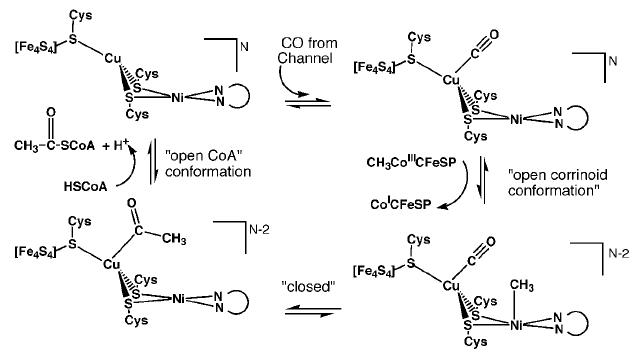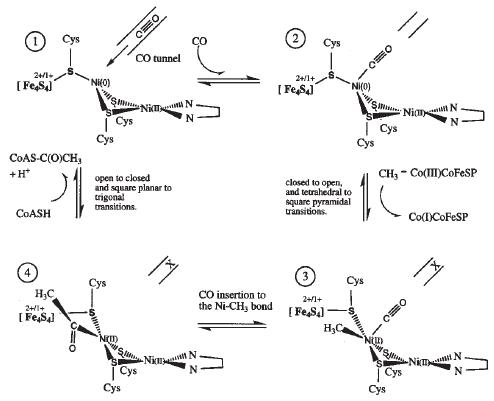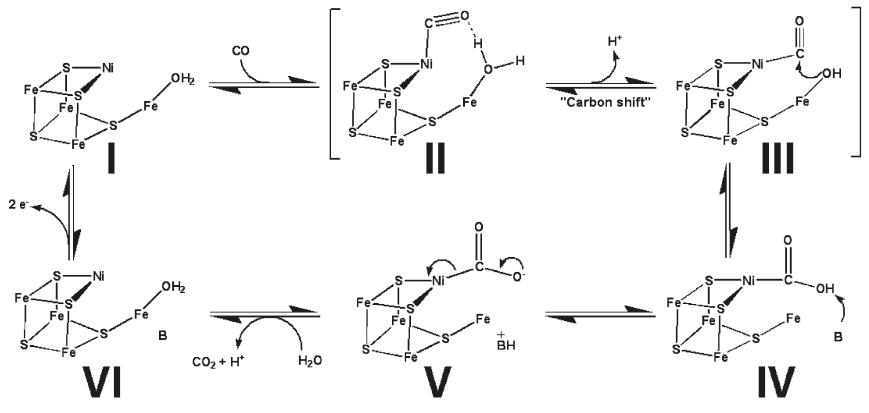Sandbox Reserved 496
From Proteopedia
(→'''Structure''') |
|||
| Line 20: | Line 20: | ||
==='''Structure'''=== | ==='''Structure'''=== | ||
---- | ---- | ||
| - | The CODH/ACS enzyme from ''M. thermoacetica'' is an <scene name='Sandbox_Reserved_496/Codh_acs_tetramer/2'> | + | The CODH/ACS enzyme from ''M. thermoacetica'' is an <scene name='Sandbox_Reserved_496/Codh_acs_tetramer/2'>α2β2 tetramer</scene> with seven metalloclusters. Each 674 residue <scene name='Sandbox_Reserved_496/Beta_subunits/2'>β subunit </scene> carries out CODH activity, while each 729 residue <scene name='Sandbox_Reserved_496/Alpha_subunits/1'>α subunit</scene> is responsible for ACS activity. From the N-terminus to C-terminus, <scene name='Sandbox_Reserved_496/Beta_secondary/1'> β subunit domains</scene> are as follows: an α-helical domain (residues 1-257) followed by two α/β Rossmann-like domains (residues 262-458 and 463-674). The β subunit has 57% helical and 9% β-sheet character with 31 helices and 15 β-strands. The <scene name='Sandbox_Reserved_496/Alpha_secondary/1'>α subunit is also comprised of three domains</scene>, two with α+β folds and a third with a helical region (residues 1-154) at the N-terminus of a Rossmann (six-stranded α/β) fold (residues 155-316) which is similar to a portion of the β subunit structure <ref name="Cu"/> <ref name="Xe">PMID:18293927</ref>. Overall, the α subunit has 50% helical and 14% β-sheet character with 36 helices and 22 β-strands. |
| - | <scene name='Sandbox_Reserved_496/Beta_metalloclusters/1'>Five of the metalloclusters</scene> (<font color='red'>'''two B-'''</font>, <font color='blue'>'''two C-'''</font>, and <font color='green'>'''one D-cluster'''</font>) are located in the β<sub>2</sub> portion of the protein with a B- and C-cluster in each β subunit and the sole D-cluster bridging the two subunits. The B- and D-clusters consist of [Fe<sub>4</sub>S<sub>4</sub>] centers that serve to transfer electrons. As the active site in each β subunit where CODH activity occurs, the <scene name='Sandbox_Reserved_496/Beta_c_cluster/2'>C-clusters are composed of a Fe -[ | + | <scene name='Sandbox_Reserved_496/Beta_metalloclusters/1'>Five of the metalloclusters</scene> (<font color='red'>'''two B-'''</font>, <font color='blue'>'''two C-'''</font>, and <font color='green'>'''one D-cluster'''</font>) are located in the β<sub>2</sub> portion of the protein with a B- and C-cluster in each β subunit and the sole D-cluster bridging the two subunits. The B- and D-clusters consist of [Fe<sub>4</sub>S<sub>4</sub>] centers that serve to transfer electrons. As the active site in each β subunit where CODH activity occurs, the <scene name='Sandbox_Reserved_496/Beta_c_cluster/2'>C-clusters are composed of a Fe -[NiFe3S4] cage </scene> with the unique Fe coordinated by a bridging sulfur ion, His283, and Cys317 <ref name="Zn">PMID:12627225</ref>. The B- and D-clusters are positioned in relation to the α-helical domain of the β subunit, while the C-clusters are aligned through interactions with both Rossmann-like domains <ref name="Xe"/>. A ligand binding study with the native CODH/ACS structure and with cyanide used as competitive inhibitor for CO showed that H<sub>2</sub>O/OH<sup>-</sup> binds the C-cluster at the unique Fe and CO binds the C-cluster at the Ni ion <ref name="CN"/>. |
| - | The remaining two metalloclusters (both A-clusters) are located in the two α subunits of the CODH/ACS protein. As the active site of ACS activity in each α subunit, the A-clusters are composed of a [Fe<sub>4</sub>S<sub>4</sub>] center bridged to a binuclear site. There is some debate regarding the metal ions present in the binuclear site; either <scene name='Sandbox_Reserved_496/Alpha_a_cluster/1'>both A-clusters are [ | + | The remaining two metalloclusters (both A-clusters) are located in the two α subunits of the CODH/ACS protein. As the active site of ACS activity in each α subunit, the A-clusters are composed of a [Fe<sub>4</sub>S<sub>4</sub>] center bridged to a binuclear site. There is some debate regarding the metal ions present in the binuclear site; either <scene name='Sandbox_Reserved_496/Alpha_a_cluster/1'>both A-clusters are [Fe4S4]-Cu-Ni</scene> <ref name="Cu"/> or one A-cluster is <scene name='Sandbox_Reserved_496/A_cluster_ni_ni/1'>[Fe4S4]-Ni-Ni</scene> while the other is <scene name='Sandbox_Reserved_496/A_cluster_zn_ni/1'>[Fe4S4]-Zn-Ni</scene> <ref name="Zn"/>. The [Fe<sub>4</sub>S<sub>4</sub>] center is coordinated by Cys506, Cys509, Cys518, and Cys528 with Cys509 also forming the bridge between the [Fe<sub>4</sub>S<sub>4</sub>] and the [http://en.wikipedia.org/wiki/Proximal#Proximal_and_distal proximal] metal ion. Furthermore, the distal metal ion is coordinated by Cys595, Gly596, and Cys597 with Cys595 and Cys597 also connecting the distal and the proximal metal ions. Only the [Fe<sub>4</sub>S<sub>4</sub>]-Ni-Ni A-cluster is in an open conformation, the other two site types with Cu or Zn as the proximal ion are in closed form. |
| Line 40: | Line 40: | ||
'''β subunit reactions''' | '''β subunit reactions''' | ||
| - | C-cluster (CODH activity): | + | C-cluster (CODH activity): CO<sub>2</sub> + 2H<sup>+</sup> + 2e<sup>-</sup> ↔ CO + H<sub>2</sub>O |
B- and D-clusters: electron transfer | B- and D-clusters: electron transfer | ||
| Line 47: | Line 47: | ||
'''α subunit reactions''' | '''α subunit reactions''' | ||
| - | A-cluster (ACS activity): | + | A-cluster (ACS activity): CH<sub>3</sub>-Co(III)-CFeSP + CO + HSCoA ↔ CH<sub>3</sub>-CO-SCoA + Co(I)-CFeSP + H<sup>+</sup> |
| Line 58: | Line 58: | ||
| - | Mechanism 2 proposes that CO binds to the proximal Ni ion after exiting the tunnel. The A-cluster then changes from the closed to the open conformation which closes the hydrophobic CO tunnel and provides a site for methyl group binding on the proximal Ni as it transitions from Ni(0) to Ni(II). Next, the bound CO inserts into the Ni-CH3 bond to produce an acetyl intermediate. Lastly, deprotonated CoA-S- attacks the carbonyl carbon of the acetyl group to produce acetyl-CoA and the proximal Ni is reduced back to Ni(0) <ref name="Zn"/>. Note that this mechanism differs from the former by binding both CO and | + | Mechanism 2 proposes that CO binds to the proximal Ni ion after exiting the tunnel. The A-cluster then changes from the closed to the open conformation which closes the hydrophobic CO tunnel and provides a site for methyl group binding on the proximal Ni as it transitions from Ni(0) to Ni(II). Next, the bound CO inserts into the Ni-CH3 bond to produce an acetyl intermediate. Lastly, deprotonated CoA-S<sup>-</sup> attacks the carbonyl carbon of the acetyl group to produce acetyl-CoA and the proximal Ni is reduced back to Ni(0) <ref name="Zn"/>. Note that this mechanism differs from the former by binding both CO and CH<sub>3</sub> to the proximal metal ion and also the A-cluster stays open between methylation and CoA acetylation. |
{{clear}} | {{clear}} | ||
[[Image:C_cluster.JPG|frame|Proposed mechanism for CODH activity in the C-cluster. <ref name="CN"/>]] | [[Image:C_cluster.JPG|frame|Proposed mechanism for CODH activity in the C-cluster. <ref name="CN"/>]] | ||
| - | In the proposed catalytic action of the C-cluster, CO first binds the Ni ion followed by deprotonation of the Fe bound water to yield a reactive hydroxide which promotes nucleophilic attack of CO by the hydroxide. Next, the Ni-COOH intermediate is deprotonated to Ni-COO<sup>-</sup> which allows release of | + | In the proposed catalytic action of the C-cluster, CO first binds the Ni ion followed by deprotonation of the Fe bound water to yield a reactive hydroxide which promotes nucleophilic attack of CO by the hydroxide. Next, the Ni-COOH intermediate is deprotonated to Ni-COO<sup>-</sup> which allows release of CO<sub>2</sub> as the C-cluster is reduced to a new redox state. Then, electrons are shuttled between the B- and D-clusters to reoxidize the C-cluster to its original redox state <ref name="CN"/>. This catalytic cycle is of course operated in reverse to reduce CO<sub>2</sub> to CO and allow subsequent production of acetyl-CoA . |
{{clear}} | {{clear}} | ||
| Line 69: | Line 69: | ||
==='''Possible Applications'''=== | ==='''Possible Applications'''=== | ||
---- | ---- | ||
| - | Since CODH/ACS consumes | + | Since CODH/ACS consumes CO<sub>2</sub> it plays a direct part in the reduction of greenhouse gases by converting CO<sub>2</sub> into an intermediate which can transformed into more desirable products such as alcohols and acids. A novel application in which CODH/ACS plays a role is the production of bioethanol from renewable natural resources such as wood, grasses, and agricultural residues (ex. corn stover). In this process, the biomass undergoes [http://en.wikipedia.org/wiki/Gasification gasification] to yield CO, CO<sub>2</sub>, and H<sub>2</sub>. The gases are subsequently fed to bacterial reactor systems containing organisms which utilize the Wood-Ljungdahl pathway and thus produce ethanol. The main goal is to produce a renewable energy source that may be used as an alternative to petroleum. However, at this time, the flux of carbon through the Wood-Ljungdahl pathway does not tend to favor ethanol production so much work remains to be done in this area. On the other hand, the Wood-Ljungdahl pathway does produce significant levels of acetic acid, and to this extent, the pathway is considered a biological equivalent to the [http://en.wikipedia.org/wiki/Monsanto_process Monsanto process] for industrial acetic acid production <ref name="Berg"/>. Roughly 10% of the total biological acetic acid production is attributable to anaerobic, autotrophic bacteria which possess CODH/ACS enzymes. |
==='''References'''=== | ==='''References'''=== | ||
Revision as of 01:00, 3 May 2012
|Bold text
| This Sandbox is Reserved from 13/03/2012, through 01/06/2012 for use in the course "Proteins and Molecular Mechanisms" taught by Robert B. Rose at the North Carolina State University, Raleigh, NC USA. This reservation includes Sandbox Reserved 451 through Sandbox Reserved 500. | |||||||
To get started:
More help: Help:Editing For more help, look at this link: http://www.proteopedia.org/wiki/index.php/Help:Getting_Started_in_Proteopedia
Bifunctional Carbon Monoxide Dehydrogenase/Acetyl-CoA Synthase (CODH/ACS)
IntroductionCarbon monoxide dehydrogenase/acetyl-CoA synthase (CODH/ACS) is a bifunctional protein which acts as both an oxidoreductase and a transferase by reducing carbon dioxide to carbon monoxide (or the reverse oxidation of carbon monoxide to carbon dioxide) and then catalyzing the synthesis of acetyl-CoA from carbon monoxide, coenzyme A, and the methyl group of an corrinoid iron-sulfur protein. This enzyme plays a key role in the Wood-Ljungdahl pathway which is used by anaerobic, autotrophic bacteria such as Moorella thermoacetica (f. Clostridium thermoaceticum) and Clostridium ljungdahlii for gaseous carbon fixation. End products of the Wood-Ljungdahl pathway include cell biomass, acids (ex. acetate and butyrate), and alcohols (ex. ethanol and butanol) – all of which derive from acetyl-CoA. The Wood-Ljungdahl pathway is also the most energetically favorable carbon fixation pathway, but its use is confined to only obligate, anaerobic species [1]. Since the discovery of the Wood-Ljungdahl pathway in the early 1980’s, significant effort has been put into trying to characterize the substrate binding activity of CODH/ACS with the M. thermoacetica protein used as the model in most case studies [2]. However, little progress was made in defining the exact structure of the protein with crystal structures until the 2000’s. Several reasons why CODH/ACS has received so much attention include the fact that it contains highly disputed metalloclusters, its use of biological organometallic intermediates in reactions, and its contribution to reducing environmental pollutants [3] [4].
StructureThe CODH/ACS enzyme from M. thermoacetica is an with seven metalloclusters. Each 674 residue carries out CODH activity, while each 729 residue is responsible for ACS activity. From the N-terminus to C-terminus, are as follows: an α-helical domain (residues 1-257) followed by two α/β Rossmann-like domains (residues 262-458 and 463-674). The β subunit has 57% helical and 9% β-sheet character with 31 helices and 15 β-strands. The , two with α+β folds and a third with a helical region (residues 1-154) at the N-terminus of a Rossmann (six-stranded α/β) fold (residues 155-316) which is similar to a portion of the β subunit structure [5] [12]. Overall, the α subunit has 50% helical and 14% β-sheet character with 36 helices and 22 β-strands.
Mechanism of Action Proposed mechanism 1 for ACS activity with Cu-Ni ions in the binuclear site of the A-cluster. [5] β subunit reactions C-cluster (CODH activity): CO2 + 2H+ + 2e- ↔ CO + H2O B- and D-clusters: electron transfer
A-cluster (ACS activity): CH3-Co(III)-CFeSP + CO + HSCoA ↔ CH3-CO-SCoA + Co(I)-CFeSP + H+
Mechanism 1 suggests that CO created at the C-cluster travels through the hydrophobic tunnel and binds to Cu. Next, the A-cluster switches to an open corrinoid conformation so that the methyl group may be transferred from the corrinoid iron-sulfur protein to the distal Ni ion of the active site. The cluster reverts back to a solvent protected, closed form to generate the acetyl intermediate, and then reopens to allow HSCoA to bind. HSCoA likely binds in the large cavity between the three domains of the α subunit where six Arg residues and Trp418 coincide. Finally, HSCoA is deprotonated and acetylated to form acetyl-CoA [5].  Proposed mechanism 2 for ACS activity with Ni-Ni ions in the binuclear site of the A-cluster. [13]
 Proposed mechanism for CODH activity in the C-cluster. [2] In the proposed catalytic action of the C-cluster, CO first binds the Ni ion followed by deprotonation of the Fe bound water to yield a reactive hydroxide which promotes nucleophilic attack of CO by the hydroxide. Next, the Ni-COOH intermediate is deprotonated to Ni-COO- which allows release of CO2 as the C-cluster is reduced to a new redox state. Then, electrons are shuttled between the B- and D-clusters to reoxidize the C-cluster to its original redox state [2]. This catalytic cycle is of course operated in reverse to reduce CO2 to CO and allow subsequent production of acetyl-CoA . Possible ApplicationsSince CODH/ACS consumes CO2 it plays a direct part in the reduction of greenhouse gases by converting CO2 into an intermediate which can transformed into more desirable products such as alcohols and acids. A novel application in which CODH/ACS plays a role is the production of bioethanol from renewable natural resources such as wood, grasses, and agricultural residues (ex. corn stover). In this process, the biomass undergoes gasification to yield CO, CO2, and H2. The gases are subsequently fed to bacterial reactor systems containing organisms which utilize the Wood-Ljungdahl pathway and thus produce ethanol. The main goal is to produce a renewable energy source that may be used as an alternative to petroleum. However, at this time, the flux of carbon through the Wood-Ljungdahl pathway does not tend to favor ethanol production so much work remains to be done in this area. On the other hand, the Wood-Ljungdahl pathway does produce significant levels of acetic acid, and to this extent, the pathway is considered a biological equivalent to the Monsanto process for industrial acetic acid production [1]. Roughly 10% of the total biological acetic acid production is attributable to anaerobic, autotrophic bacteria which possess CODH/ACS enzymes. References
|
